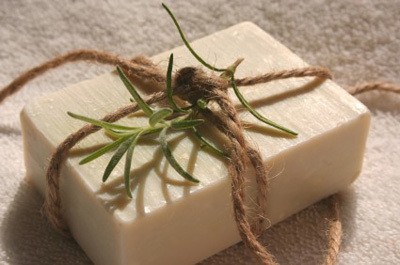
From the culinary to the medicinal, there are hundreds (maybe thousands) of ways to use herbs - including making scented herbal soaps. From the simple to the complex, there are dozens of methods for making soap. Here's one that is both easy and economical because it uses only fresh herbs from your garden, and slivers of leftover soap - no lye required!
Using Leftover Soap
Ideally, the leftover pieces of soap you use should be unscented or, at least, only very lightly scented. Highly scented soaps will compete with and overpower the aromas from your essential oils. The color of the soap doesn't matter, in fact, if you want to change the color, you can find soap coloring at craft stores that carry soap-making supplies.
Remnants from glycerin based soaps (soaps that you can see through) will melt fairly quickly and evenly. The opaque (solid colored) soaps like Dial, Ivory, etc., melt a lot more slowly. To speed up the process, grate your leftovers with a vegetable grater or chop them into tiny pieces. Melt your soap scraps on the stove top in a double boiler over simmering heat. Whatever you do, DO NOT melt opaque soaps in the microwave or you'll have a huge, foamy mess on your hands.
Making Essential Oils
Essential oils are what give herbal soaps their scent. The strongest and longest lasting aromas come from oils that contain herbs like rosemary, lavender, and thyme. Other herbs to experiment with include mints (spearmint or peppermint), lemon verbena, lemon balm, chamomile, comfrey, and roses.To make essential oils, place about 4 ounces (1 1/2 cups, tightly packed) of a single herb's leaves or petals in an airtight glass jar with 4 ounces of extra virgin olive oil. Keep the jar in a cool, dark place for about 3 weeks. After 3 weeks, strain the oil to remove the plant debris. You now have an aromatic essential oil. Use it to make your soaps, or add a few drops to your bath water for a refreshing and relaxing aroma.
To make "new" soap, collect slivers of used soap, then grate them with a vegetable or cheese grater and melt them in a double boiler over simmering heat. Stir often! As the soap starts to soften, help it along by adding a few drops of water and mashing it with a potato masher. Add water as sparingly as possible. Too much will keep the soap soft and prevent it (or at least prolong it) from setting up. As it is, your finished soap will probably be softer than the soap you started with.
Once the old soap is melted, add about 1 tablespoon (more or less to your tastes) of the essential herbal or floral oil of your choice, and continue stirring for several minutes. Pour the mixture into plastic molds (available at craft stores), or into small containers that have been lightly greased with olive or vegetable oil. Leave soaps for at least two days before unmolding and/or cutting.
Put the grated soap in the top of a double boiler or into the microwave set on low power. Melt the soap. Stir in the olive oil, a drop or two at a time. Stir in the honey and essential oil, then remove from the heat. Continue to stir until the mixture is well blended.Pour into molds, cover and leave them to set up and harden - this may take up to two weeks. Unmold and wrap in wax paper to store.
Additional tips:

About The Author: Ellen Brown is an environmental writer and photographer and the owner of Sustainable Media, an environmental media company that specializes in helping businesses and organizations promote eco-friendly products and services. Contact her on the web at http://www.sustainable-media.com
Add your voice! Click below to comment. ThriftyFun is powered by your wisdom!
Since a few months ago, I've always wanted to make my own home-made soaps. I bought soaps at a temporary thrift store downtown and it had broken my skin out.
Add your voice! Click below to comment. ThriftyFun is powered by your wisdom!